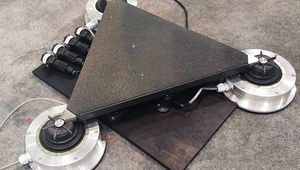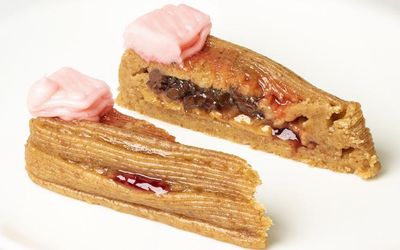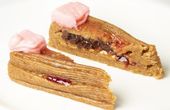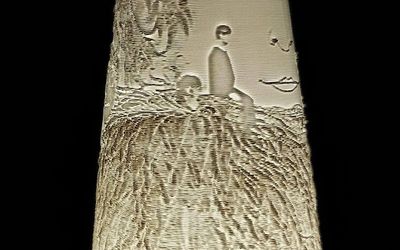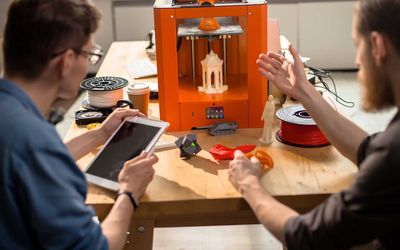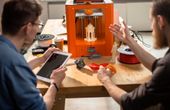Makerbot Replicator+
A desktop 3D printer by Markerbot features bendable build plate with grip surface, on-board camera, mobile app, and swappable extruders for flexibility and convenience within classroom settings.
Technical Specifications
| Dimensions | 52.8 x 44.1 x 41.0 cm [20.8 x 17.4 x 16.2 in] |
| Weight | 18.3kg [40.4lbs] |
| Construction | PC ABS with Powder-Coated Steel Reinforcement, Aluminum Casting and Extrusions for Motion Components |
| Build Surface | Grip Surface |
| Build Plate Leveling | Factory Leveled |
| Stepper Motors | 1.8° step angle with 1/16 micro-stepping |
| XY Positioning Precision | 11 microns [0.0004 in] |
| Z Positioning Precision | 2.5 microns [0.0001 in] |
| Camera resolution | 640 x 480 @ 4fps |
| Build Volume | 29.5 x 19.5 x 16.5 cm [11.6 x 7.6 x 6.5 in] 9,492 cm3 [573 in3] |
| Layer Resolution | 100 microns [0.0039 in] |
| Material Diameter | 1.75 mm [0.069 in] |
| Nozzle Diameter | 0.4 mm [0.015 Iin] |
| Extruder Compatibility | Smart Extruder+, Tough Smart Extruder+, Experimental Extruder |
| Material Compatibility | MakerBot PLA Material - Large Spool, Small Spool |
| MakerBot Tough Material - Large Spool | |
| Additional materials such as bronzefill, copperfill, and woodfill | |
| Software | MakerBot Print Software, MakerBot Mobile |
| Supported File Types | STL, OBJ |
| Operating Systems | Windows (7, 10), Mac OS X (10.9+) |
Overview
The MakerBot Replicator+ achieves quality 3D printing results through its features. It uses the Smart Extruder+, on top of every standard feature from its predecessors, to ensure accessible 3D printing. It has an onboard camera, USB, Ethernet and Wi-Fi, and LCD display suitable for educational institutions for lesson planning, STEM projects, and designing exercises that will facilitate 21st-century career skills.
MakerBot Replicator+ uses fused deposition modeling (FDM) technology. It creates 3D solid objects from melted MakerBot PLA filament. The MakerBot Print translates 3D design files as instructions transferred to the MakerBot Replicator+ using a USB drive, a USB cable, or the local network. The Replicator+ melts the filament, squeezing it onto the build plates as thin lines, which build the object layer by layer.
Design
Made from PC ABS, Makerbot Replicator+ is built with powder-coated steel reinforcement. It has a build volume of 29.5 X 19.5 X 16.5 cm [11.6 X 7.6 X 6.5 in] and an aluminum casting and extrusions meant for motion components. Its layer resolution is 100 microns (0.0039IN), while its material diameter is 1.75 mm (0.069in). The maximum material flow rate is approximately 15 mm3/sec, while the traveling speed of the print head can reach up to 175 mm/sec.
Build Plate with Grip Build Surface
The Grip Surface made out of polycarbonate film helps print adhere better for reduced warping and curling. Meanwhile, the bendable Flex Build Plate eases the removal of the print. The large factory-leveled build plate has stepper motors with a 1.8-degree step angle at 1/16 micro-stepping. The XY positioning precision is at 11 microns (0.004IN), and the Z position is at 2.5 microns (0.0001IN).
Extruder Compatibility
MakerBot 3D printers have swappable extruders, allowing flexibility in print options while offering convenience in maintenance. The printer’s Smart Extruder+ has a nozzle diameter of 0.4mm or 0.015in. It features improved connectivity and enhanced homing while reducing clogs and jams drastically. It is easily replaceable or swappable, minimizing downtime while continuing printing. Smart Extruder+ can detect filament absence, pausing the print and notifying the MakerBot Print and MakerBot Mobile. The printer also has the Tough Smart Extruder+ and the Experimental Extruder.
On-Board Camera
The camera has a 640 x 480 resolution at 4 fps. It remotely monitors the print progress and gives the user a view of the entire process.
User Interface
The LCD display with an intuitive dial sets up and maintains the 3D printer. It previews print files and accesses the object library to provide computer-free and easy access to commands, menus, and the cloud library.
Connectivity
Sending print files to the printer is available using a USB, USB drive, Ethernet, or Wi-Fi. The printer setting is accessible through the MakerBot Print and can be controlled remotely using the MakerBot Mobile.
Software
As Replicator+ is cloud-enabled, it receives remote control via the MakerBot Print or the MakerBot Mobile app. The print software controls multiple printers for printing on multiple build plates simultaneously or sequentially. It likewise stores, accesses and organizes various design files found in the cloud-enabled library. The free-to-download MakerBot Print software is compatible with Windows (7, 10) and Mac OS X (10.9+), supporting OBJ as well as STL types of files.
Material Compatibility
The device works well with large and small spools of MakerBot PLA materials. This material is perfect for early concept models as it is easy to use and works with breakaway supports. This non-toxic material is biodegradable as it is a corn-based plastic meant for industrial processes. Not only is it easy to print, but also reduces warping and curling to a minimum.
The printer is also compatible with MakerBot Tough materials on large spools. This material is likewise easy to use and is best matched for mid-stage prototypes. Its advantage over PLA includes machinability, durability, and pliability for assemblies and snap fits.
Other materials include copperfill, woodfill, and bronzefill. The material storage location is found in the open-back loaded drawer.


